Preview of SDSU Spring Camp – Defense and Special Teams
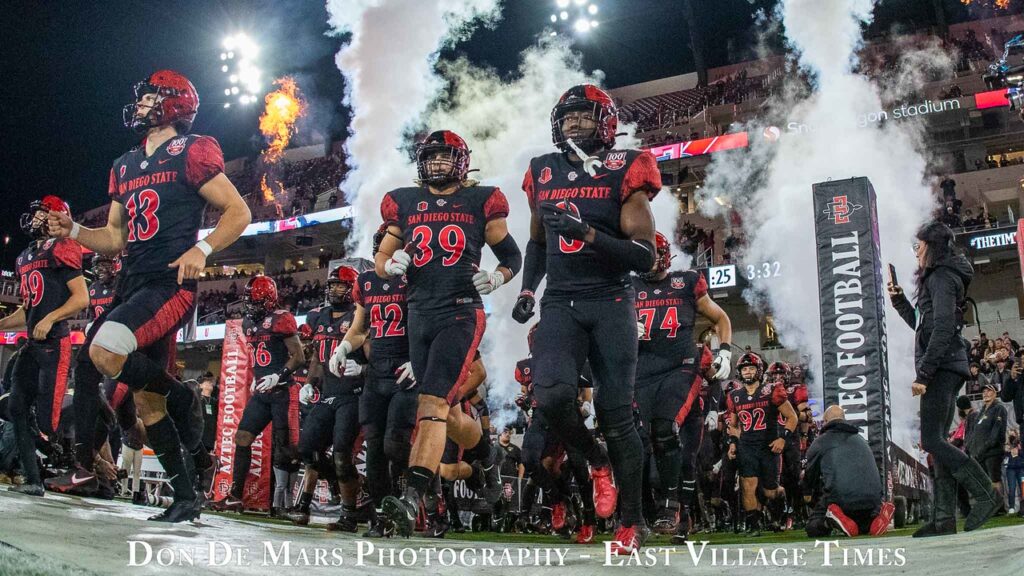
SDSU runs out of the tunnel against Air Force. (Don De Mars/EVT)
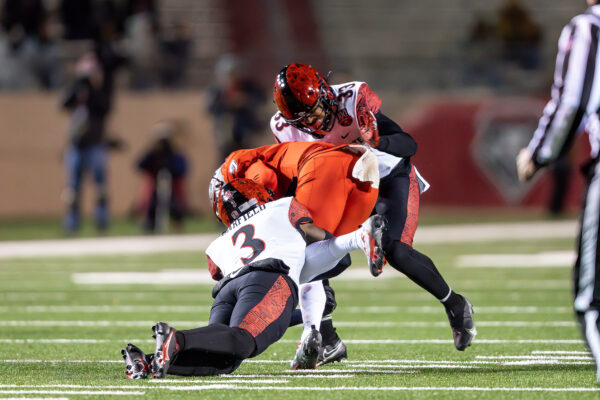
1. Can SDSU’s secondary lead the way?
2020 was the last year the strength of SDSU’s defense was in its back end. Three of those starters are on NFL rosters, and the other two have spent time in the league. Over the past two seasons, the Aztecs have been led by their front six.
Dez Malone, Noah Avinger, Noah Tumblin, Dallas Branch, Cedarious Barfield, Davaughn Celestine, and Patrick McMorris have had the benefit of maturing as players in an ideal environment, playing behind one of the best fronts in America. In 2023, it is their turn to support an inexperienced defensive front as it comes of age.
To accomplish that, they need to be better than they were last year. Growth is expected with more years in the program and time on the field, but it is never linear nor automatic. During the allotted 15 spring practices beginning on Monday, SDSU’s secondary can improve in key ways.
– After switching from safety last spring, Malone emerged as the team’s best cornerback. The rest of the group must match his level of play or risk younger players like Chris Johnson entering the conversation for playing time. Avinger and Tumblin have flashed playmaking ability but still lack the consistency needed to fulfill their all-conference potential. Branch continues to be a playmaker but needs to tackle better for the 3-3-5 to thrive.
– With Barfield and Celestine starting at the end of the year, the distinction between boundary and field warrior disappeared. Each played one side of the field regardless of which hashmark the ball was on. They improved as the year went on but did not play at an elite level. It would not be a surprise to see Eric Butler, Josh Hunter, or newcomer JD Coffey push for time. Shutting the door on that possibility begins with the returning starters recognizing routes better, blanketing slot receivers, and creating turnovers.
– Communication is key, and the Aztecs are losing their best communicators on and off the field. Caden McDonald, Michael Shawcroft, and Jonah Tavai were all students of the game. Their preparation before practice allowed them to get everyone lined up correctly. That role will fall to the secondary. Assignment errors have occurred regularly on the back end, limiting those is also a must.
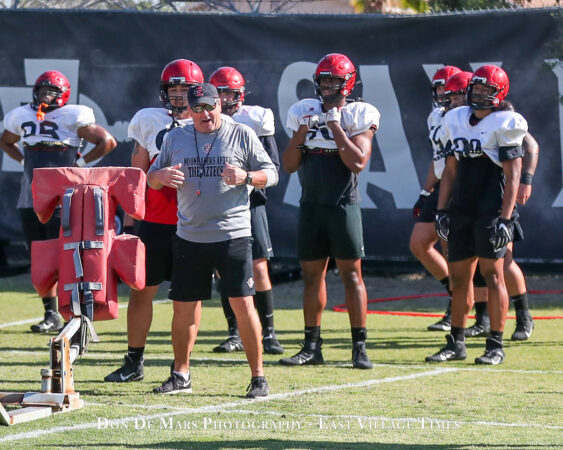
2. Is there enough depth at defensive line?
Two seasons, two All-Americans. Cameron Thomas and Jonah Tavai are some of the best players to ever set foot on the Mesa. They were part of arguably the best line in school history in 2021. It was that group who completely dominated Utah up front, holding the Utes to 70 yards rushing. From 2019 to the present, the Aztecs are the only team to hold Utah under 100 yards on the ground.
With Tavai elevating his play in 2022 to match Thomas’s 2021, the drop-off in production of the line last year could be traced to its lack of depth. In leading SDSU to a 12-2 record, the Aztecs staff had six linemen who saw time, keeping the players at the top of the depth chart fresh. Last season, that number was reduced by one, forcing the starters to play longer, and they wore down as the game progressed.
In the offseason, SDSU brought eight new players to the defensive line. Four are currently with the team, and spring camp will go a long way in determining which tiers the linemen play at next season.
– Daniel Okpoko and Garrett Fountain proved valuable in their roles last year. In his first year at the position, Fountain was something of a revelation. He was tied for eighth on the team in tackles (41), fifth in tackles for loss (6), and fourth in sacks (4). Considered essentially a fourth starter last year, he should be even better in 2023.
It could be argued Okpoko was SDSU’s most improved player. He started the year as an afterthought and ended it by earning an invitation to rejoin the team for this upcoming year. SDSU needs another leap in production from the Canadian senior. Beginning in the spring, the duo will need to prove they can play better and longer than they have to this point in their careers.
– Samulela Tuihalamaka transferred in from Oklahoma State. The Aztecs went to the juco ranks to add Talib “The General” Salahuddin, Tupu Alualo, and Joseph Hall. They brought those players in to compete for a spot. With a few scholarships available and potentially more after spring, the staff needs to know what they have and if the players currently on the roster can form a competent rotation.
– SDSU brought in so many new players because of a gap on the roster in the junior class. Surrounding this group is a collection of athletes who need to step up for the defense to continue playing at a high level. At NT, Nassir Sims came in as a high-profile recruit but has yet to live up to the billing. Now a senior, is this the year Sims actualizes his potential? Darrion Dalton is entering his third year on the Mesa and should also be pushing for time.
Seniors Wyatt Draeger and Dylan Taylor lead a host of sophomores and redshirt freshmen looking to compete at defensive end. Ryan Henderson and Dominic Oliver are two of the younger players mentioned most by the staff.
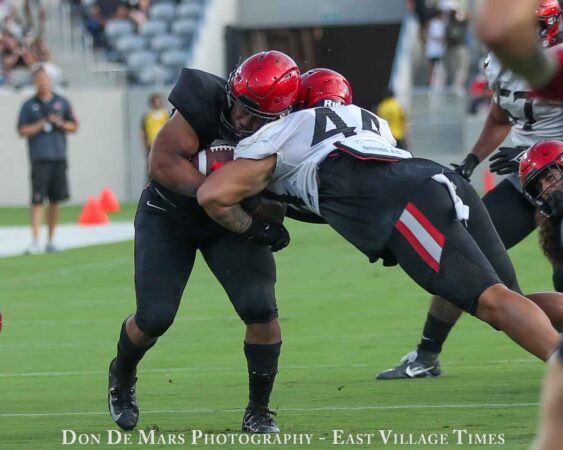
3. Who will lead the Aztecs’ linebackers?
Zyrus Fiaseu took over at middle linebacker halfway through the season. Cooper McDonald started the first half of the year at SAM LB. They return, but it is possible there will be three new starters from the group in 2023. Whomever defensive coordinator and linebackers coach Kurt Mattix chooses to line up will have the unenviable task of replacing Shawcroft and Caden McDonald.
343 career tackles, 23.5 sacks, and dozen turnovers graduated a season ago. Like anything complex, the stalwarts’ impact cannot be reduced to numbers alone. The 3-3-5 works only if SDSU wins at the defense’s inflection points. It was at places of tension like reading bubble screens, getting back into a play on an option, or taking away the first read of the passer that Shawcroft’s and McDonald’s play counted most. Making plays off script without leaving gaping holes is the challenge ahead of the group in spring.
– Is this the year Vai Kaho makes his mark? There is no question he is physically ready, but his instincts for the game are lacking. Nearly every time there is an option, Kaho sells out to attack the QB, and he runs himself out of plays. Consistency was the main reason Fiaseu passed Kaho last year. Growing into an all-around LB could unleash one of the most explosive downhill players on the west coast.
– Cody Moon joins the mix as a transfer from New Mexico. Playing in Rocky Long’s 3-3-5, he has experience in the type of defense SDSU’s runs. Philosophically, Mattix’ version of the defense is the same, but it varies from Long’s schematically. The former SDSU head coach runs a more balanced attack, which allows for more deception, but also is prone to giving up more big plays. Mattix prefers to match up with the opposition, which carves out more specific roles for his players. Finding a role for Moon in spring will be important.
– Potentially, the most exciting story for the defense in spring is Kyron White switching positions. A backup aztec safety throughout his career, White played LB in the final game of the regular season against Air Force and impressed the coaches enough to make the switch. SDSU is deep at safety, so finding creative ways to take advantage of the roster’s strength is smart.
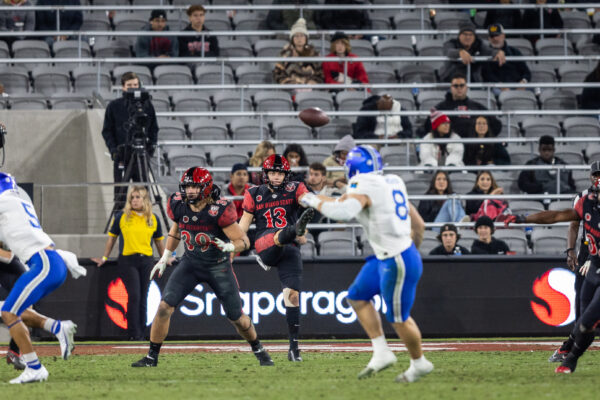
4. Can SDSU’s special teams find consistency?
There were highs and lows for the special teams a season ago. Jordan Byrd returned multiple touchdowns but was not a consistent threat throughout the year. The Aztecs had a challenging time blocking on kickoffs and punts. Special teams coordinator Doug Deakin is one of the more prepared coaches in the game and will no doubt have a plan to correct the issue.
SDSU’s recipe for success depends a lot on the third phase of the game. Lapses by the offense and defense will take the lion’s share of the blame for the 7-6 season last year, but there were multiple times when better play from the special teams could have added more wins to the ledger. Spring camp is the perfect time to find consistency in all aspects.
[wpedon id=”49075″ align=”right”]
– Jack Browning was better in 2022 than anyone could have hoped. The Mountain West Special Teams Player of the Year and hometown hero began last spring in a competition for all kicking roles. He won them and excelled. Even in college football, manning all duties is rare, so another spring working on how to balance everything while improving in each is Browning’s task.
– Jordan Byrd and Jesse Matthews have graduated. They were first and second on the depth chart at punt returner because they could consistently catch the ball. Before anyone can step up and be a weapon as a returner, they have to secure the punt. Spring is the perfect time to find players who are comfortable in the role. Mekhi Shaw is likely first in line. If one of the team’s speedsters, Kenan Christon or Josh Nicholson, could learn to catch punts smoothly, on paper, they could be the best replacement for Byrd.
– Part of the field goal duo that was responsible for 20 successful attempts in 25 tries graduated. Hilltop High School’s David Deldago was the team’s primary holder a year ago, and spring is a great time for a teammate to develop comfort with Browning and long snapper Ryan Wintermeyer. WR Darius De Los Reyes from Lincoln High could be the answer.
My earliest sport’s memory involve tailgating at the Murph, running down the circular exit ramps, and seeing the Padres, Chargers and Aztecs play. As a second generation Aztec, I am passionate about all things SDSU. Other interests include raising my four children, being a great husband and teaching high school.